
Postage stamps and postal history of Switzerland
Encyclopedia
This is a survey of the postage stamp
s and postal history
of Switzerland
.
(pre-stamp postal history here)
s of Zürich
, Geneva
and Basel
for their own use, with the first federal issues coming several years later.
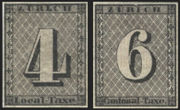 The Zurich 4 and 6
The Zurich 4 and 6
was first put on sale 1 March 1843, making it the second type of stamp in the world, after the UK
's Penny Black
three years earlier. The issue consisted of two imperforate stamps printed separately, each in five types, in sheets of 100, one with a large numeral "4" and the other with a "6", both inscribed "Zürich" at the top. The 4-rappen
stamp was also inscribed "LOCAL-TAXE" at the bottom, since it was intended to pay for letters mailed within a city, while the 6-rappen, inscribed "CANTONAL-TAXE", was for use with letters going anywhere in the canton. The design was lithographed in black by Orell, Fuessli, and Company, with a pattern of fine red lines underneath, to discourage counterfeit
ing. Initially the red line were horizontal, but starting in 1846 they were printed vertically. These stamps were popular from the start, but were not printed in large numbers and are quite scarce today, with values ranging from US$1,500 to $20,000 depending on type.
Canton Zurich also issued a stamp in 1850, known to collectors as the Winterthur issue, depicting the Swiss federal cross and a posthorn, which served as a transitional issue until the stamps of the Swiss federal government made their appearance later that same year.
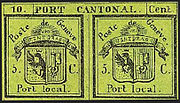 Geneva brought out its own stamp issue on 1 October 1843, the "Double Geneva
Geneva brought out its own stamp issue on 1 October 1843, the "Double Geneva
". Like the first Zürich issue, it consisted of pairs of stamps, each printed in black on yellow-green paper, depicting the city's arms, and inscribed "Poste de Genéve" at the top and "Port local" at the bottom. But an additional inscription, reading "10 PORT CANTONAL Cent" ran across the top of each pair. The idea was that the user could cut out a single stamp to pay the intra-commune rate, and a pair to make up the inter-commune rate. Only 6,000 of the doubles were ever printed, and , intact used doubles typically go for around US$35,000 at auction.
In 1845, Geneva switched to conventional single 5c stamps. In 1849 it printed a 4c stamp featuring the federal cross in black and red, and similar 5c designs in 1850 and 1851.
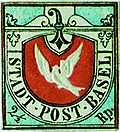 Basel only ever issued one stamp, the "Basel Dove
Basel only ever issued one stamp, the "Basel Dove
" of 1845. This was a 2½-rappen value featuring a white embossed dove
carrying a letter in its beak, and inscribed "STADT POST BASEL", a design by the architect
Melchior Berry. It is printed in black, crimson
, and blue
, making it the world's first tri-colored stamp.
 The adoption of the federal constitution in 1848 made it practical to issue confederation-wide stamps, and the first of these came out in 1850 (the exact date is uncertain). All used the same basic design, a Swiss cross surmounted by a posthorn, but there were a number of variations. The local-rate stamps had a value of 2½ rappen, with some inscribed "ORTS-POST" (German
The adoption of the federal constitution in 1848 made it practical to issue confederation-wide stamps, and the first of these came out in 1850 (the exact date is uncertain). All used the same basic design, a Swiss cross surmounted by a posthorn, but there were a number of variations. The local-rate stamps had a value of 2½ rappen, with some inscribed "ORTS-POST" (German
) and "POSTE LOCALE" (French
). This was the first of many multi-language issues. For longer-distance mail, the 5-rappen stamp was inscribed "RAYON" and the 10-rappen, "RAYON II". Initially the stamps were issued with a black frame separating the white cross from the red background, but as a technically incorrect rendition of the Swiss arms, these were withdrawn.
In 1852 a 15-rappen/centime value inscribed "RAYON III" was issued, using the same design as previously, but printed entirely in vermilion
.
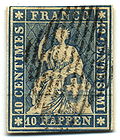 All of the preceding issues were declared invalid on 1 October 1854, and replaced with the seated allegorical figure "Helvetia
All of the preceding issues were declared invalid on 1 October 1854, and replaced with the seated allegorical figure "Helvetia
", the first of several issues known as "seated Helvetias". The figure was embossed but only the outline was colored, making it rather hard to pick out. This was the first issue to deal with the multiple languages of Switzerland; in addition to the word "FRANCO" at the top, the other three sides listed the denomination in rappen, centimes, and (Italian
) centesimi.
The issue was also notable for the use of a colored silk
thread running horizontally through the paper
, as an anti-counterfeit
ing measure. (In the illustration to the left, the thread is faintly visible about 1/3 of the distance from the bottom of the stamp, looking almost like a crease.)
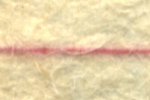 A number of values were printed between 1854 and 1862, ranging from 5 rappen to 1 franc
A number of values were printed between 1854 and 1862, ranging from 5 rappen to 1 franc
, and philatelists distinguish them further by type of paper and color of thread. The commonest type surviving today is the 5-rappen brown on thick paper with a green thread, costing US$20 used; certain other types are rare, and the pale yellow-green shade of the 40-rappen value will go for $7,000 or more.
A new design with more legible seated Helvetia appeared in 1862, now sporting a "watermark
" consisting of a cross inside an ellipse (not a true watermark because it was impressed into the paper after printing), and for the first time, perforations
. The units of currency disappeared, with "HELVETIA" inscribed at the top and "FRANCO" at the bottom. Initially printed on white wove paper, the stamps switched to granite paper in 1881. (The paper has red and blue silk threads, clearly visible in the larger image of the stamp to the left.) The stamps continued in use until 1883; many of them are common and cheaply available today, although legitimate cancellations on the granite paper varieties are uncommon because of the short period of use.
 In 1882, the low value stamps (up to 15c) were numerals, while the higher values featured a "Standing Helvetia". These continued in use, with a number of variations in color, perforation, and paper, until 1907. 1900 saw Switzerland's first commemorative stamp
In 1882, the low value stamps (up to 15c) were numerals, while the higher values featured a "Standing Helvetia". These continued in use, with a number of variations in color, perforation, and paper, until 1907. 1900 saw Switzerland's first commemorative stamp
s, a set of three values issued for the 25th anniversary of the Universal Postal Union
, with an allegorical design featuring various symbols of communication.
's son holding a crossbow
and an apple pierced by an arrow for values below 10c, a bust of Helvetia for 10c to 15c values, and another seated Helvetia for higher values.
The William Tell's son design went through several redrawings, including a temporary move of the bowstring in front of the crossbow's stock. From 1914 on, a portrait of William Tell himself was used for values between 10c and 30c.
Also in 1914, the first of many scenic stamps were issued. The 5fr depicted the Rütli meadow, while the 3fr and 10fr stamps showed the Mythen and Jungfrau
mountain
s, respectively.
The first semi-postal stamp was issued in 1913, but regular annual issues did not start until 1915. For many years an issue of 3-5 stamps came out on 1 December each year, until 1972.
An set of three stamps in 1919 celebrated peace at the end of World War I
. Stamp printing experienced some difficulties during this period, and a variety of surcharge
s were needed in 1915 and 1921. The UPU was noted on its 50th anniversary in 1924 with two stamps, one depicting its building in Bern and the other the location of the 1874 Congress.
In about 1930 Switzerland began to use "grilled gum", a light grill applied along the gum to counteract the tendency for gummed stamps to curl. The grill is most obvious on mint stamps, but is faintly visible on used stamps as well. This was abandoned around 1944.
The next definitive series was a set of scenic views issued in 1934. The designs were typographed
, resulting in a vigorous albeit somewhat crude-looking appearance, and they were superseded by engraved versions of the same basic designs, beginning in 1936.
Several commemorative issues appeared in the 1930s, then in 1941 came new definitives honoring Swiss military heroes. Another definitive set in 1945 marked the end of the war; the higher values of this were issued in small numbers, and are relatively expensive today.
The definitive series of 1949 depicted achievements of Swiss technology. Since that time, Swiss stamps have generally followed a regular pattern; an issue of about four commemoratives on a single date in the spring, and a similar group in the fall, as well as a Europa issue, usually in the spring. Starting in the 1980s, there have been additional themed issues; for instance, in 1993 an issue of four stamps featured works of art by Swiss women.
Postage stamp
A postage stamp is a small piece of paper that is purchased and displayed on an item of mail as evidence of payment of postage. Typically, stamps are made from special paper, with a national designation and denomination on the face, and a gum adhesive on the reverse side...
s and postal history
Postal history
Postal history is the study of postal systems and how they operate and, or, the study of postage stamps and covers and associated material illustrating historical episodes of postal systems...
of Switzerland
Switzerland
Switzerland name of one of the Swiss cantons. ; ; ; or ), in its full name the Swiss Confederation , is a federal republic consisting of 26 cantons, with Bern as the seat of the federal authorities. The country is situated in Western Europe,Or Central Europe depending on the definition....
.
(pre-stamp postal history here)
Cantonal issues
The first stamps used in Switzerland were issued by the cantonCantons of Switzerland
The 26 cantons of Switzerland are the member states of the federal state of Switzerland. Each canton was a fully sovereign state with its own borders, army and currency from the Treaty of Westphalia until the establishment of the Swiss federal state in 1848...
s of Zürich
Canton of Zürich
The Canton of Zurich has a population of . The canton is located in the northeast of Switzerland and the city of Zurich is its capital. The official language is German, but people speak the local Swiss German dialect called Züritüütsch...
, Geneva
Geneva
Geneva In the national languages of Switzerland the city is known as Genf , Ginevra and Genevra is the second-most-populous city in Switzerland and is the most populous city of Romandie, the French-speaking part of Switzerland...
and Basel
Basel
Basel or Basle In the national languages of Switzerland the city is also known as Bâle , Basilea and Basilea is Switzerland's third most populous city with about 166,000 inhabitants. Located where the Swiss, French and German borders meet, Basel also has suburbs in France and Germany...
for their own use, with the first federal issues coming several years later.
Zürich

Zurich 4 and 6
The Zürich 4 and 6 were the first postage stamps issued in continental Europe, on 1 March 1843. Both were inscribed "Zürich" at the top.The 4-rappen stamp was also inscribed "Local-Taxe" at the bottom, since it was intended to pay for letters mailed within the city, while the 6-rappen, inscribed...
was first put on sale 1 March 1843, making it the second type of stamp in the world, after the UK
United Kingdom
The United Kingdom of Great Britain and Northern IrelandIn the United Kingdom and Dependencies, other languages have been officially recognised as legitimate autochthonous languages under the European Charter for Regional or Minority Languages...
's Penny Black
Penny Black
The Penny Black was the world's first adhesive postage stamp used in a public postal system. It was issued in Britain on 1 May 1840, for official use from 6 May of that year....
three years earlier. The issue consisted of two imperforate stamps printed separately, each in five types, in sheets of 100, one with a large numeral "4" and the other with a "6", both inscribed "Zürich" at the top. The 4-rappen
Rappen
A Rappen originally was a variant of the medieval Pfennig common to the Alemannic German regions Alsace, Sundgau and Northern Switzerland. As with other German pennies, its half-piece was a Haller, the smallest piece which was struck.Today, one-hundredth of a Swiss franc is still officially...
stamp was also inscribed "LOCAL-TAXE" at the bottom, since it was intended to pay for letters mailed within a city, while the 6-rappen, inscribed "CANTONAL-TAXE", was for use with letters going anywhere in the canton. The design was lithographed in black by Orell, Fuessli, and Company, with a pattern of fine red lines underneath, to discourage counterfeit
Counterfeit
To counterfeit means to illegally imitate something. Counterfeit products are often produced with the intent to take advantage of the superior value of the imitated product...
ing. Initially the red line were horizontal, but starting in 1846 they were printed vertically. These stamps were popular from the start, but were not printed in large numbers and are quite scarce today, with values ranging from US$1,500 to $20,000 depending on type.
Canton Zurich also issued a stamp in 1850, known to collectors as the Winterthur issue, depicting the Swiss federal cross and a posthorn, which served as a transitional issue until the stamps of the Swiss federal government made their appearance later that same year.
Geneva

Double Geneva
The Double Geneva is a rare Swiss stamp that was issued by the City of Geneva in 1843, making it the third-oldest stamp of the European continent after the Zurich 4 and 6 , and the British Penny Black and Two penny blue, .. It bears the name Double Geneva for the double image on the stamp and its...
". Like the first Zürich issue, it consisted of pairs of stamps, each printed in black on yellow-green paper, depicting the city's arms, and inscribed "Poste de Genéve" at the top and "Port local" at the bottom. But an additional inscription, reading "10 PORT CANTONAL Cent" ran across the top of each pair. The idea was that the user could cut out a single stamp to pay the intra-commune rate, and a pair to make up the inter-commune rate. Only 6,000 of the doubles were ever printed, and , intact used doubles typically go for around US$35,000 at auction.
In 1845, Geneva switched to conventional single 5c stamps. In 1849 it printed a 4c stamp featuring the federal cross in black and red, and similar 5c designs in 1850 and 1851.
Basel

Basel Dove
The Basel Dove is a notable stamp issued by the Swiss canton of Basel. It was issued on 1 July 1845 with a value of 2½-rappen and was the only stamp issued by Basel. At the time each canton was responsible for its own postal service and there were no uniform postal rates for Switzerland until after...
" of 1845. This was a 2½-rappen value featuring a white embossed dove
Dove
Pigeons and doves constitute the bird family Columbidae within the order Columbiformes, which include some 300 species of near passerines. In general terms "dove" and "pigeon" are used somewhat interchangeably...
carrying a letter in its beak, and inscribed "STADT POST BASEL", a design by the architect
Architect
An architect is a person trained in the planning, design and oversight of the construction of buildings. To practice architecture means to offer or render services in connection with the design and construction of a building, or group of buildings and the space within the site surrounding the...
Melchior Berry. It is printed in black, crimson
Crimson
Crimson is a strong, bright, deep red color. It is originally the color of the dye produced from a scale insect, Kermes vermilio, but the name is now also used as a generic term for those slightly bluish-red colors that are between red and rose; besides crimson itself, these colors include...
, and blue
Blue
Blue is a colour, the perception of which is evoked by light having a spectrum dominated by energy with a wavelength of roughly 440–490 nm. It is considered one of the additive primary colours. On the HSV Colour Wheel, the complement of blue is yellow; that is, a colour corresponding to an equal...
, making it the world's first tri-colored stamp.
Local mail and rayon stamps

German language
German is a West Germanic language, related to and classified alongside English and Dutch. With an estimated 90 – 98 million native speakers, German is one of the world's major languages and is the most widely-spoken first language in the European Union....
) and "POSTE LOCALE" (French
French language
French is a Romance language spoken as a first language in France, the Romandy region in Switzerland, Wallonia and Brussels in Belgium, Monaco, the regions of Quebec and Acadia in Canada, and by various communities elsewhere. Second-language speakers of French are distributed throughout many parts...
). This was the first of many multi-language issues. For longer-distance mail, the 5-rappen stamp was inscribed "RAYON" and the 10-rappen, "RAYON II". Initially the stamps were issued with a black frame separating the white cross from the red background, but as a technically incorrect rendition of the Swiss arms, these were withdrawn.
In 1852 a 15-rappen/centime value inscribed "RAYON III" was issued, using the same design as previously, but printed entirely in vermilion
Vermilion
Vermilion is an opaque orangish red pigment, similar to scarlet. As a naturally occurring mineral pigment, it is known as cinnabar, and was in use around the world before the Common Era began. Most naturally produced vermilion comes from cinnabar mined in China, and vermilion is nowadays commonly...
.
Helvetias

Helvetia
Helvetia is the female national personification of Switzerland, officially Confœderatio Helvetica, the "Helvetic Confederation".The allegory is typically pictured in a flowing gown, with a spear and a shield emblazoned with the Swiss flag, and commonly with braided hair, commonly with a wreath as...
", the first of several issues known as "seated Helvetias". The figure was embossed but only the outline was colored, making it rather hard to pick out. This was the first issue to deal with the multiple languages of Switzerland; in addition to the word "FRANCO" at the top, the other three sides listed the denomination in rappen, centimes, and (Italian
Italian language
Italian is a Romance language spoken mainly in Europe: Italy, Switzerland, San Marino, Vatican City, by minorities in Malta, Monaco, Croatia, Slovenia, France, Libya, Eritrea, and Somalia, and by immigrant communities in the Americas and Australia...
) centesimi.
The issue was also notable for the use of a colored silk
Silk
Silk is a natural protein fiber, some forms of which can be woven into textiles. The best-known type of silk is obtained from the cocoons of the larvae of the mulberry silkworm Bombyx mori reared in captivity...
thread running horizontally through the paper
Postage stamp paper
Postage stamp paper is the foundation or substrate of the postage stamp to which the ink for the stamp's design is applied to one side and the adhesive is applied to the other...
, as an anti-counterfeit
Counterfeit
To counterfeit means to illegally imitate something. Counterfeit products are often produced with the intent to take advantage of the superior value of the imitated product...
ing measure. (In the illustration to the left, the thread is faintly visible about 1/3 of the distance from the bottom of the stamp, looking almost like a crease.)

Franc
The franc is the name of several currency units, most notably the Swiss franc, still a major world currency today due to the prominence of Swiss financial institutions and the former currency of France, the French franc until the Euro was adopted in 1999...
, and philatelists distinguish them further by type of paper and color of thread. The commonest type surviving today is the 5-rappen brown on thick paper with a green thread, costing US$20 used; certain other types are rare, and the pale yellow-green shade of the 40-rappen value will go for $7,000 or more.
A new design with more legible seated Helvetia appeared in 1862, now sporting a "watermark
Watermark
A watermark is a recognizable image or pattern in paper that appears as various shades of lightness/darkness when viewed by transmitted light , caused by thickness or density variations in the paper...
" consisting of a cross inside an ellipse (not a true watermark because it was impressed into the paper after printing), and for the first time, perforations
Postage stamp separation
For postage stamps, separation is the means by which individual stamps are made easily detachable from each other.Methods of separation include:# perforation: cutting rows and columns of small holes...
. The units of currency disappeared, with "HELVETIA" inscribed at the top and "FRANCO" at the bottom. Initially printed on white wove paper, the stamps switched to granite paper in 1881. (The paper has red and blue silk threads, clearly visible in the larger image of the stamp to the left.) The stamps continued in use until 1883; many of them are common and cheaply available today, although legitimate cancellations on the granite paper varieties are uncommon because of the short period of use.

Commemorative stamp
A commemorative stamp is a postage stamp, often issued on a significant date such as an anniversary, to honor or commemorate a place, event or person. The subject of the commemorative stamp is usually spelled out in print, unlike definitive stamps which normally depict the subject along with the...
s, a set of three values issued for the 25th anniversary of the Universal Postal Union
Universal Postal Union
The Universal Postal Union is an international organization that coordinates postal policies among member nations, in addition to the worldwide postal system. The UPU contains four bodies consisting of the Congress, the Council of Administration , the Postal Operations Council and the...
, with an allegorical design featuring various symbols of communication.
20th century
A new definitive series in 1907 showed William TellWilliam Tell
William Tell is a folk hero of Switzerland. His legend is recorded in a late 15th century Swiss chronicle....
's son holding a crossbow
Crossbow
A crossbow is a weapon consisting of a bow mounted on a stock that shoots projectiles, often called bolts or quarrels. The medieval crossbow was called by many names, most of which derived from the word ballista, a torsion engine resembling a crossbow in appearance.Historically, crossbows played a...
and an apple pierced by an arrow for values below 10c, a bust of Helvetia for 10c to 15c values, and another seated Helvetia for higher values.
The William Tell's son design went through several redrawings, including a temporary move of the bowstring in front of the crossbow's stock. From 1914 on, a portrait of William Tell himself was used for values between 10c and 30c.
Also in 1914, the first of many scenic stamps were issued. The 5fr depicted the Rütli meadow, while the 3fr and 10fr stamps showed the Mythen and Jungfrau
Jungfrau
The Jungfrau is one of the main summits in the Bernese Alps, situated between the cantons of Valais and Bern in Switzerland...
mountain
Mountain
Image:Himalaya_annotated.jpg|thumb|right|The Himalayan mountain range with Mount Everestrect 58 14 160 49 Chomo Lonzorect 200 28 335 52 Makalurect 378 24 566 45 Mount Everestrect 188 581 920 656 Tibetan Plateaurect 250 406 340 427 Rong River...
s, respectively.
The first semi-postal stamp was issued in 1913, but regular annual issues did not start until 1915. For many years an issue of 3-5 stamps came out on 1 December each year, until 1972.
An set of three stamps in 1919 celebrated peace at the end of World War I
World War I
World War I , which was predominantly called the World War or the Great War from its occurrence until 1939, and the First World War or World War I thereafter, was a major war centred in Europe that began on 28 July 1914 and lasted until 11 November 1918...
. Stamp printing experienced some difficulties during this period, and a variety of surcharge
Overprint
An overprint is an additional layer of text or graphics added to the face of a postage stamp or banknote after it has been printed. Post offices most often use overprints for internal administrative purposes such as accounting but they are also employed in public mail...
s were needed in 1915 and 1921. The UPU was noted on its 50th anniversary in 1924 with two stamps, one depicting its building in Bern and the other the location of the 1874 Congress.
In about 1930 Switzerland began to use "grilled gum", a light grill applied along the gum to counteract the tendency for gummed stamps to curl. The grill is most obvious on mint stamps, but is faintly visible on used stamps as well. This was abandoned around 1944.
The next definitive series was a set of scenic views issued in 1934. The designs were typographed
Typography
Typography is the art and technique of arranging type in order to make language visible. The arrangement of type involves the selection of typefaces, point size, line length, leading , adjusting the spaces between groups of letters and adjusting the space between pairs of letters...
, resulting in a vigorous albeit somewhat crude-looking appearance, and they were superseded by engraved versions of the same basic designs, beginning in 1936.
Several commemorative issues appeared in the 1930s, then in 1941 came new definitives honoring Swiss military heroes. Another definitive set in 1945 marked the end of the war; the higher values of this were issued in small numbers, and are relatively expensive today.
The definitive series of 1949 depicted achievements of Swiss technology. Since that time, Swiss stamps have generally followed a regular pattern; an issue of about four commemoratives on a single date in the spring, and a similar group in the fall, as well as a Europa issue, usually in the spring. Starting in the 1980s, there have been additional themed issues; for instance, in 1993 an issue of four stamps featured works of art by Swiss women.
Sources
- Stanley Gibbons Ltd: various catalogues
- Encyclopaedia of Postal History
- Stuart Rossiter & John Flower: The Stamp Atlas

